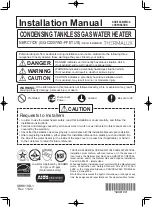
26
pilot. If the water was extremely hot and is now cold, the high
limit safety temperature shut off may have put out the burner
and pilot. Refer to “High Temperature Shut Off System” in this
section.
4. The gas control knob must be turned to the “ON” position.
5. The temperature adjustment dial may be set too low. See the
“Temperature Regulation” section.
6. The gas company can check the gas input to see if it is correct. An
underfired water heater will not heat water as quickly.
7. Look for leaking or open hot water faucets. Make sure all are
closed.
8 . The cold water inlet temperature may be colder during the
winter months. It will take longer to heat the water and seem like
less hot water.
9. If you cannot find what is wrong, call the local gas utility and/or
plumbing contractor.
WATER IS TOO HOT
1. The temperature adjustment dial may be set too high. See the
“Temperature Regulation” section.
NOTE: A period of time is necessary after an adjustment has
been made for the water temperature to reach the new
temperature setting.
2. If lower temperature settings will not lower the water temperature,
shut off the water heater and call the local gas utility.
VENTING SYSTEM INSPECTION
At least once a year a visual inspection should be made of the venting
system. You should look for:
1. Obstructions which could cause improper venting. The combustion
and ventilation air flow must not be obstructed.
2. Damage or deterioration which could cause improper venting or
leakage of combustion products.
WARNING
BE SURE THE VENT PIPING IS PROPERLY CONNECTED TO
PREVENT ESCAPE OF DANGEROUS FLUE GASSES WHICH
COULD CAUSE DEADLY ASPHYXIATION.
WARNING
OBSTRUCTIONS AND DETERIORATED VENT SYSTEMS MAY
PRESENT SERIOUS HEALTH RISK OR ASPHYXIATION.
WARNING
CHEMICAL VAPOR CORROSION OF THE FLUE AND VENT
SYSTEM MAY OCCUR IF AIR FOR COMBUSTION CONTAINS
CERTAIN CHEMICAL VAPORS. SPRAY CAN PROPELLANTS,
CLEANING SOLVENTS, REFRIGERATOR AND AIR CONDITIONER
REFRIGERANTS, SWIMMING POOL CHEMICALS, CALCIUM
AND SODIUM CHLORIDE, WAXES, BLEACH AND PROCESS
CHEMICALS ARE TYPICAL COMPOUNDS WHICH ARE
POTENTIALLY CORROSIVE.
WARNING
IF AFTER INSPECTION OF THE VENT SYSTEM YOU FOUND
SOOTING OR DETERIORATION, SOMETHING IS WRONG. CALL
THE LOCAL GAS UTILITY TO CORRECT THE PROBLEM AND
CLEAN OR REPLACE THE FLUE AND VENTING BEFORE
RESUMING OPERATION OF THE WATER HEATER.
BURNER INSPECTION
WARNING
FLOOD DAMAGE TO A WATER HEATER MAY NOT BE READILY
VISIBLE OR IMMEDIATELY DETECTIBLE. HOWEVER, OVER A
PERIOD OF TIME A FLOODED WATER HEATER WILL CREATE
DANGEROUS CONDITIONS WHICH CAN CAUSE DEATH, SERIOUS
BODILY INJURY, OR PROPERTY DAMAGE. CONTACT A
QUALIFIED SERVICE TECHNICIAN OR CONTRACTOR TO
REPLACE A FLOODED WATER HEATER. DO NOT ATTEMPT TO
REPAIR THE UNIT! IT MUST BE REPLACED!
At least once a year a visual inspection should be made of the main
burner and pilot burner. The drawing is for your reference.
You should check for sooting which is not normal and will impair proper
combustion.
WARNING
SOOT BUILD-UP INDICATES A PROBLEM THAT REQUIRES
CORRECTION BEFORE FURTHER USE. TURN “OFF” GAS TO
WATER HEATER AND LEAVE “OFF” UNTIL REPAIRS ARE MADE,
BECAUSE FAILURE TO CORRECT THE CAUSE OF THE SOOTING
CAN RESULT IN A FIRE CAUSING DEATH, SERIOUS BODILY
INJURY, OR PROPERTY DAMAGE.
BURNER CLEANING
In the event your burner needs cleaning, use the following
instructions:
If inspection of the burner shows that cleaning is required, turn the gas
control knob clockwise
to the “OFF” position.
Loose deposits on or around the burner can be removed by carefully
using the hose of a vacuum cleaner. If the burner needs to be removed











































